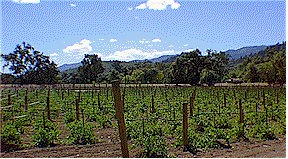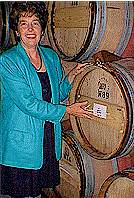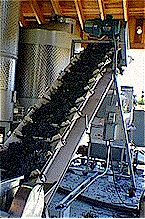|
||||
| NECTAR OF THE GODS | ||||
| OR TRUE SCIENCE? | ||||
| By Brage Green-Thomas | ||||
| CNS News & Features | ||||
| It has been described as poetry in a bottle. Nectar of the Gods. The ultimate expression of art. It is all of these. And to those who grow the grapes, nurture them, press them and bottle them, it is so much more. It borders on a labor of love. To the rest of us, however, it's the final complement to a delicious meal. When looking at the label to see if you've bought it before, most likely the last thing running through your mind is when the grapes were harvested and how much rain fell between November and March. Rather, what's probably running through your mind as you look at this bottle of wine is something along the lines of, "Oh, I've had this before. It's good. Hey, is it on sale?" | ||||
| Words like that make a winemaker cringe. So, to avoid these simple mistakes, I'd like to tell you a thing or two about growing grapes and making wine. Winemaking is a true science, but who does the mixing and matching isn't necessarily a scientist in a white lab coat. In fact, it's a mysterious combination of the winemaker and Mother Nature, though the mixture is never in equal parts. | ||||
| WEATHER | ||||
| In simple terms, warm is good. A lot of rain is bad, and rich soil should be saved for the begonias in the backyard. Growth of the vines isn't as esoteric a process as you might think. When the climate is warm and the soil is rich, the vines grow rapidly and abundantly. Cool weather brings slower growth, but better grapes. | ||||
| Sharon Whitney of Duckhorn Vineyards, located north of St. Helena, shared some gardening tips with me as well as the ideal weather conditions for growing great grapes. | ||||
|
||||
| So, what is considered ideal weather? | ||||
| "Now, our friends in France," said Whitney, "they don't get a lot of sun, it rains a lot, and they have cold, windy weather, yet, they still produce great wines. The Napa Valley, on the other hand, has perfect weather for growing grapes. It rains from November to March, and it's dry from April to October. You couldn't ask for better conditions. This year, however, we're having a heat wave, which is pushing the sugar level up, so we're harvesting early." | ||||
| HARVESTING | ||||
| Typically, harvesting the grapes takes place during the month of September. September 1st through the end of October, to be exact. Some still practice the lost art of picking the grapes by hand, while others have gone the way of modern technology. How modern, you may ask? Well, nothing high-tech by Silicon Valley standards, but this machine is big enough to dominate the vineyard, grab only the biggest, and fattest grapes, then send them back on a conveyer belt for pressing and fermentation. | ||||
| If you're a hopeless romantic, you imagine families from the old world, their worn, khaki pants rolled up to their knees, their skirts held to their mid-thighs as they dance clockwise and counter-clockwise | ||||
| in an oversized tank, mashing the grapes with their feet, singing the family harvesting song....well, okay, maybe not singing, but there's definitely soundtrack potential. | ||||
|
||||
| Fermentation takes place for a month or two where the yeast, which forms on the skins of the grapes, converts the sugars from the juice into alcohol and carbon dioxide. The carbon dioxide bubbles away during the aging process and then...viola! Wine! | ||||
| WHERE DO YOU GO FOR A GOOD GLASS OF WINE? | ||||
| Northern California has been blessed with exquisite scenery, magical weather conditions and some of the best wineries this side of France. The more popular vineyards are found up in the "wine country," north of San Francisco in Sonoma and Napa Valley. Hidden treasures in Sonoma, like the Ravenswood winery and Stag's Leap, grow some delicious grapes and offer a charming atmosphere for tasting and learning. Napa Valley and St. Helena are also neighbors that provide coveted grapes for such luscious wines from Rombauer Vineyards, Charles Krug, Sterling Vineyards and Duckhorn Vineyards. | ||||
| Other such pristine wine growing locations are right here in the Bay Area. The Livermore Valley is home to several vineyards, one, of course, being Wente Vineyards, where I learned first-hand that making wine is a process one part people power, two parts Mother Nature and one part luck (which can be attributed to Mother Nature's mood). | ||||
| WHAT DO YOU SERVE WITH PIZZA? | ||||
| You've just ordered a magnificent pizza with sun-dried tomatoes and artichoke hearts and you thought it might be nice to have a bottle of wine with it. But which one? Well, common sense says, go red. But, there are a lot of reds out there, so how do you know which one will taste the best with your savory pizza? Try a Merlot, Zinfandel or Pinot Noir. | ||||
| So the next time you're in the grocery
store or a wine shop picking out your favorite bottle of
Zinfandel or looking for a delicious bottle of Merlot to
bring to dinner at a friend's, give a brief thought to
the grapes that were grown especially for you, harvested
at the peak of their life, then crushed for your
enjoyment. Salud. |
||||
|
||||
Tom Rinaldi, Winemaster, Duckhorn Vineyards |
||||
Photo art & page design by Scott Martin |



